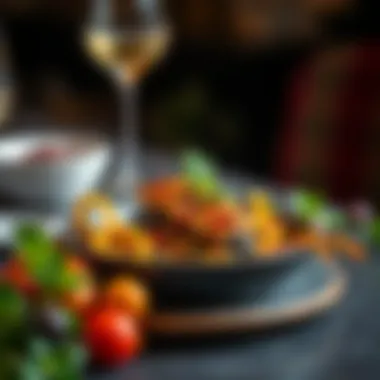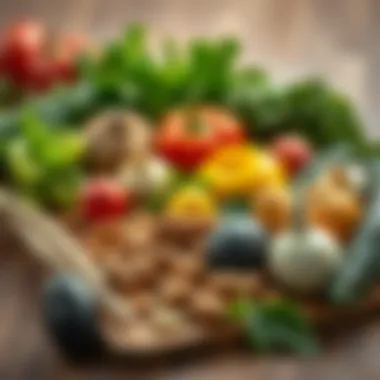Sophisticated Vegetarian Recipes for Busy Lives


Intro
In a world filled with culinary possibilities, it’s easy to see why vegetarian cuisine has gained remarkable traction. The intersection of artful presentation and flavor has given rise to elevated vegetarian dishes that are not just meals but experiences. For culinary enthusiasts, the challenge lies in creating restaurant-quality dishes within the constraints of busy lives, often led by professionals or homemakers balancing multiple responsibilities.
This guide brings forth a selection of sophisticated vegetarian recipes designed for those who appreciate gastronomic creativity yet desire simplicity in preparation. Each of these recipes embodies a philosophy that great meals don’t have to be labor-intensive. Instead, they can be a symphony of flavors achieved through thoughtful ingredient selection, refining cooking techniques, and masterful pairings.
The beauty of vegetarian cooking lies in its potential to transform modest ingredients into delightful creations. Herein, readers will find not just recipes but also insights into how they can enhance their culinary repertoire. The goal is to inspire home cooks—be they novices just starting their culinary journey or seasoned kitchen veterans looking for fresh ideas—to indulge in creating lavish dishes that surprise and satisfy.
Preamble to Elevated Vegetarian Cuisine
The world of vegetarian cuisine has evolved significantly in recent years. Gone are the days when vegetarian dishes were merely side notes on a menu, often lacking creativity and excitement. Today, elevated vegetarian cuisine is celebrated for its artful presentation, bold flavors, and the ability to showcase ingredients in novel ways. This evolution not only caters to the growing number of people embracing vegetarianism but also resonates with culinary enthusiasts seeking to explore plant-based cooking.
One fundamental aspect of elevated vegetarian dishes is that they break the mold of traditional cooking. The approach emphasizes the use of quality ingredients, imagination, and technique, allowing even the simplest elements to assume a starring role on the plate. Whether it's transforming humble carrots into a gourmet dish worthy of a fine dining experience or crafting a salad that marries unexpected flavors, the artistry in vegetarian cooking encourages creativity.
The Rationale Behind Vegetarianism
Vegetarianism, at its core, is rooted in a myriad of motivations that stretch beyond dietary preferences. Environmentally, many people choose to adopt this lifestyle to mitigate their carbon footprint and reduce the exploitation of natural resources. For instance, studies have shown that livestock farming contributes disproportionately to greenhouse gas emissions. As more individuals become conscious of their impact on the planet, plant-based diets are sought as a sustainable alternative.
Health concerns play a significant role in this movement as well. Research suggests a diet rich in fruits and vegetables can lead to reduced risks of chronic diseases. There's a growing recognition of how certain meat products associated with high levels of saturated fats can affect long-term health negatively. As plant-based ingredients are often nutrient-dense, many see a vegetarian diet as an opportunity to enhance their well-being. Often, individuals find themselves motivated by ethical considerations as well. The desire to promote animal welfare impels people to choose a vegetarian lifestyle, encouraging them to seek out delicious and inventive ways to enjoy plant-based meals.
The Intersection of Health and Flavor
When tapping into the world of vegetarian cooking, one might assume that healthiness equates to blandness. This couldn’t be further from the truth. The intersection of health and flavor is where the magic happens in elevated vegetarian cuisine. Those in the culinary sphere have begun exploring how they can integrate vibrant ingredients to create dishes that not only nourish the body but also delight the palate.
Consider the tomato, a staple in kitchens worldwide. Not only is it a source of antioxidants, but when roasted to perfection, it brings out an explosion of umami flavors that can elevate any simple dish. The art of layering flavors plays a crucial role; start with a base of sautéed onions and garlic, and you are laying the groundwork for a dish that is both nourishing and irresistible.
"The best vegetarian dishes excite the senses just as much as they nourish the body."
Moreover, playful additions of spices can turn ordinary dishes into flavorful explosions. A pinch of smoked paprika can transform a simple vegetable stew, while fresh herbs can lift flavors through vibrant finishes. Additionally, incorporating diverse grains like quinoa or farro not only adds depth but also a wealth of nutrients.
The beauty of elevated vegetarian cuisine lies in its ability to marry health and flavor harmoniously. By understanding the balance between these elements, culinary enthusiasts can unlock a treasure trove of possibilities, making vegetarian cooking not just a necessity, but a pleasurable art form.
Essential Ingredients for Fancy Vegetarian Recipes
In the world of elevated vegetarian cooking, the ingredients you choose can make all the difference between an ordinary dish and a culinary masterpiece. These ingredients don’t just fill your plate; they tell a story, reflecting the seasons, regions, and personal tastes. By understanding the essence of each component, you can create elegant and sophisticated vegetarian recipes that resonate well with both the palate and the eye.
Exploring Seasonal Vegetables
Seasonal vegetables are the backbone of any thoughtful vegetarian recipe. Eating with the seasons not only connects you with the rhythms of nature, but it also ensures that you are using fresh produce at its peak flavor and nutritional value. The benefits include brimming taste, lower carbon footprints, and generally better costs.
Consider some of these seasonal powerhouses:
- Spring: Asparagus, peas, radishes
- Summer: Zucchini, tomatoes, bell peppers
- Fall: Pumpkins, root vegetables, kale
- Winter: Brussels sprouts, winter squash, leeks


When you select ingredients like spring peas or summer tomatoes, you're not just throwing together hotchpotch; you're creating a vivid palette of seasonal flavors that shine through in your cooking. Moreover, seasonal veggies challenge you to adapt recipes and think creatively about dishes you may have never considered.
Herbs and Spices: The Flavor Catalysts
Transforming a simple vegetable medley into a fancy dish hinges on the proper use of herbs and spices. These flavorful additions have the power to elevate your creations, turning bland into grand. From a sprinkle of fresh basil to a dash of smoked paprika, herbs and spices provide complexity without overwhelming the core ingredients.
Key herbs and spices include:
- Basil: Great for Mediterranean dishes.
- Cumin: Adds an earthy depth, perfect in stews.
- Thyme: Pairs wonderfully with roasted veggies.
- Chili flakes: A pinch can really bring some heat.
Using fresh herbs, whenever possible, creates a lively contrast to cooked components. Dried spices, though, can introduce some unexpected warmth and depth. Remember too, that balance is key; instead of being heavy-handed, playaround with small amounts until the desired profile arises.
Unconventional Proteins
While beans and lentils are tried-and-true vegetarian proteins, venturing into less traditional territory can offer not only nutrition but also exciting new textures and flavors. Ingredients like tempeh, seitan, and even jackfruit have become star performers in many sophisticated vegetarian dishes.
A few unconventional choices are:
- Quinoa: A complete protein; great in salads.
- Chickpeas: Versatile and can be roasted, blended, or served whole.
- Tofu: Its ability to absorb flavors makes it a dynamic ingredient.
- Edamame: Fresh and fulfilling, packed with protein.
By incorporating these ingredients into your dishes, you add a unique twist that impresses diners and keeps the meal interesting. These proteins also ensure that your meals are not just visually appealing but fulfilling and nutritionally balanced, allowing creativity and health to coexist.
"The right ingredients are the cornerstone of culinary artistry; they inspire and motivate creativity in every dish."
Incorporating these essential ingredients—seasonal vegetables, herbs and spices, and unconventional proteins—into your recipes is vital for achieving elegance in vegetarian cuisine. Each one adds its own character to your culinary creations, making the cooking process as enjoyable as the meal itself.
Time-Saving Techniques for Cooking
When it comes to elevated vegetarian cuisine, efficiency plays a significant role. The ability to prepare intricate dishes without spending hours in the kitchen is a game changer for culinary enthusiasts. Implementing time-saving techniques allows home cooks to enjoy the process of cooking while still producing gourmet meals that can impress.
Prep Work in Advance
Being prepared can cut down kitchen time drastically. Spend a few moments each week doing some prep work. This can be as simple as washing and chopping vegetables or marinating proteins. For instance, if you plan on making a variety of dishes throughout the week, consider chopping onions, bell peppers, and carrots all at once, storing them in airtight containers in the fridge. Not only will this save you time, but it will also ensure that you have ready-to-go ingredients at your fingertips.
Make preparing ahead part of your routine. Here are a few more tips to enhance your prep process:
- Batch chop: Chop vegetables for multiple meals at one time.
- Marinate proteins: Doing so for a day ahead can drastically improve flavor.
- Organize your space: Keep your workspace tidy to minimize distractions and streamline your workflow.
"A well-prepped kitchen is half the cooking battle won."
Batch Cooking: A Strategic Approach
Batch cooking is all about making larger quantities of meals. It’s a time-efficient way of cooking, where you can prepare large portions of a dish that can last through the week. For vegetarian meals, think of dishes that hold up well over a few days, like a hearty lentil stew or a bean chili. Cook once and eat multiple times—this method enables you to flavor up your meals even more, as the flavors develop over time.
- Choose versatile recipes: Dishes like grain bowls or soups can be easily modified with different toppings or sides throughout the week.
- Store thoughtfully: Use mason jars or microwave-safe containers, making it easy to grab and go.
- Plan your storage: Ensure you have adequate space in the fridge or freezer, particularly for meals you plan to enjoy later.


Utilizing Kitchen Gadgets Efficiently
In today’s world, kitchen gadgets can be a cook's best friend. Having tools that simplify the cooking process can save a significant amount of time. Consider tools like air fryers, instant pots, or food processors; each of these has unique capabilities that can enhance your meal prep.
- Food Processor: It can chop, slice, and puree in seconds, making it great for making dips or even mixing batter for quick breads.
- Instant Pot: This gadget allows you to cook grains, beans, and soups in a fraction of the time it would normally take.
- Air Fryer: Perfect for cooking crispy snacks without the time-consuming process of deep frying, while still keeping your meals on the healthier side.
Using these time-saving techniques, cooks can create stunning vegetarian dishes without feeling rushed. Embracing preparation, batch cooking, and gadgets makes it possible to enjoy both the art of cooking and the delight of exquisite meals.
Sophisticated Starter Recipes
In the realm of elevated vegetarian cuisine, starters serve as an invitation to the dining experience ahead. These first impressions set the tone for the meal, combining artful presentation with vibrant flavors to pique the appetite. Sophisticated starters are not just about taste; they also reflect thoughtfulness and creativity in preparation. Additionally, they often feature seasonal ingredients and exciting flavor profiles, making them essential in crafting a memorable dining experience.
When considering sophisticated starter recipes, a number of benefits emerge:
- Enhanced Flavor Profiles: Starters can combine various textures and tastes, offering a complex sensory experience from the very first bite.
- Opportunities for Creativity: This course allows cooks to experiment with ingredients and presentation, showcasing individual flair and innovation.
- Balancing the Meal: Starter dishes can serve to balance heavier mains, ensuring a well-rounded meal that appeals to various palates.
So, as you dive into creating elegant starter options, keep in mind that they serve a dual purpose: to please the eye and to tantalize the taste buds, setting the stage for the feast to follow.
Elegant Salads with a Twist
Elevating salads into elegant dining fare involves rethinking traditional components and presenting them with sophistication. Salads can be much more than lettuce and dressing; they are canvases upon which one can paint delicious flavor combinations and showcase vivid colors. For instance, instead of plain greens, consider a farro salad featuring roasted butternut squash, pomegranate seeds, and a tahini dressing for a delightful blend of textures and nutrients.
Here are key considerations:
- Ingredient Choice: Use high-quality ingredients, selecting seasonal vegetables and unique additions like nuts or seeds to add crunch and a depth of flavor.
- Dressing Innovation: Create homemade dressings that involve unexpected ingredients, such as maple syrup or soy sauce, bringing a gourmet touch to your dish.
- Presentation Matters: Plating salads with a keen eye for aesthetics can transform them into standout starters. Use wide, shallow bowls to showcase layers, heights, and colors—making the dish not just a meal but an experience.
Artful Vegetable Arrangements
The beauty of vegetarian cuisine lies in its vibrant colors and enticing forms. Artful vegetable arrangements focus on layout and aesthetic appeal. Presenting vegetables artfully can elevate them from side components to the highlight of the plate.
This technique can involve:
- Creative Slicing Techniques: Employ an array of cutting styles such as chiffonade, julienne, or spiralizing to bring dimension to platters.
- Use of Color: Choose vegetables across the spectrum—think bright reds, deep greens, and sunny yellows—to create an eye-catching display.
- Garnishes and Edible Flowers: Enhancing presentation with fresh herbs or edible flowers can add an elegant finishing touch that is both beautiful and flavorful.
"Food is art, and plates are the canvas."
When thoughtfully arranged, vegetables not only delight the palate but also captivate the eyes, ensuring that guests feel indulged right from the start. With these sophisticated starter recipes, you can impress even the most discerning culinary enthusiast.
Main Course Masterpieces
Main course masterpieces serve as the backbone of any elevated vegetarian dining experience, transforming the potentially simplistic into an elaborate feast for the senses. The significance of this section lies not just in showcasing impressive recipes, but also in emphasizing the philosophy that vegetarian cooking can be both aesthetically stunning and deeply satisfying. Understanding how to artfully compose a main course gives cooks the ability to turn an ordinary meal into a celebration, all while staying true to the principles of vegetarianism.
When crafting these masterpieces, it’s pivotal to consider various aspects such as balance of flavors, textures, and visual appeal. Not only should the dish tantalize the taste buds, but it should also make the heart sing with joy upon its presentation. The main course becomes the centerpiece of any meal, allowing diners to savor flavors from around the world, fostering an invitation for exploration and delight.


"Cooking is an observation-based process that you can’t do if you’re so focused on a recipe."
— Thomas Keller
Taking into account the busy lifestyle of modern culinary enthusiasts, these recipes are designed for elegance without unnecessary complexities. They allow the cook to shine, providing room for creativity while remaining approachable for all experience levels.
Versatile Grain Bowls
Grain bowls have made a significant impact on contemporary cuisine, serving as a canvas for layering flavors and textures that unite culinary inspirations from various regions. Often considered a health trend, these bowls can be transformed into culinary masterpieces simply by selecting the right elements. Whole grains like quinoa, farro, or brown rice provide a hearty base, while vibrant vegetables, proteins, and drizzles of flavorful sauces elevate the dining experience.
Key Components of a Grain Bowl:
- Base Grain: Acts as the foundation; choose options that resonate with the other ingredients.
- Vegetables: Incorporate seasonal produce for freshness; roasted, sautéed, or raw all add different character.
- Proteins: Explore unconventional protein sources, mudas beans or tofu can really amp it up.
- Dressings and Toppers: Homemade sauces can be the game-changer, from tangy tahini to zesty citrus vinaigrettes.
Stuffed Vegetables: A Unique Presentation
Stuffed vegetables combine bold flavors with visually appealing presentations, turning humble ingredients into showstoppers. Hollowed-out bell peppers, zucchini, or eggplant can be filled with a vibrant mix of grains, legumes, and spices, allowing for creativity in formulation. They not only serve a purpose for flavor but also allow the chef to play with color and texture.
When preparing stuffed vegetables, aim for cohesion in flavors while balancing hearty and fresh elements. For instance, a filling made of couscous, chickpeas, and sun-dried tomatoes can harmonize beautifully with fresh herbs like parsley or dill. Presentation matters too; ensuring that the stuffed vegetable stands upright and is garnished with a sprinkle of herbs creates an enticing visual as well.
Creative Pasta Dishes
Pasta is often seen as a classic comfort food, but it can be reimagined as an elevated vegetarian dish when done thoughtfully. Think beyond traditional sauces and incorporate layers of flavors that surprise and delight. Making use of whole-grain or legume-based pasta can add nutritional value while enhancing texture.
Consider seasonal ingredients such as asparagus in spring or mushrooms in autumn to infuse your dishes with freshness. A sauce of roasted garlic, olive oil, and a hint of lemon can bring depth to any dish, drawing together the wheat and the greens into a harmonious blend. Adding unexpected twists, like wilted greens or crunchy nuts, will take a simple pasta dish to a new level altogether.
Artful Accompaniments
In the realm of elevated vegetarian cuisine, the side offerings matter as much as the main courses. Artful accompaniments play a crucial role, providing not just flavor but also texture and visual appeal. They are like the supporting actors in a play; while they may not always be in the spotlight, their contribution can elevate the entire experience.
When considering these accompaniments, focus on a variety of sauces, dips, breads, and spreads. Each element should complement the meal, enhancing the flavors and textures of the main dish. Here are some key reasons to pay attention to these details:
- Cohesion: A well-chosen accompaniment can bridge the flavors of the main dish and create a harmonious overall experience.
- Textural Variety: Different textures play with our senses. Creamy dips, crispy breads, and tangy sauces all serve to create a delightful interplay on the palate.
- Visual Appeal: Colorful dips and artistically arranged breads can make a plate pop, enticing guests and enhancing the overall dining experience.
Thus, integrating sophisticated sauces and gourmet breads along with their spreads becomes paramount in constructing a meal that is not just consumed but enjoyed in its entirety.
Sublime Sauces and Dips
Sauces and dips are the invisible hands that guide our taste buds through a meal. They are often underappreciated while being vitally important. A well-crafted sauce can transform everyday ingredients into a symphony of flavors, and dips can bring together various elements of a meal.
Consider creating a smoky chipotle aioli for drizzling over grain bowls or a tahini sauce that dances harmoniously with roasted vegetables. Even a zesty mango salsa can add brightness to heavier dishes, bringing the meal to life. The key is not just in taste, but also in texture – creamy, chunky, or runny, they should engage a variety of senses.
Here’s a simple recipe for a basic herb-infused dip:
Ingredients:
- 1 cup Greek yogurt
- 1 tablespoon lemon juice
- Handful of fresh herbs (like dill or parsley)
- Salt and pepper to taste
Instructions:
- In a bowl, combine Greek yogurt and lemon juice.
- Finely chop the herbs and fold them into the yogurt.
- Season with salt and pepper.
- Serve with fresh vegetable sticks or pita chips.







